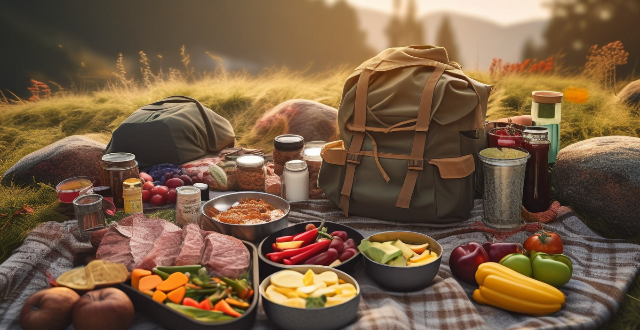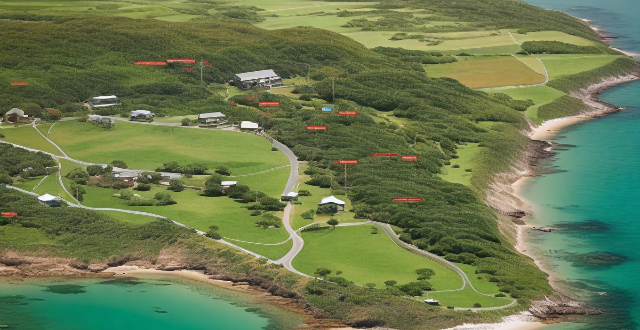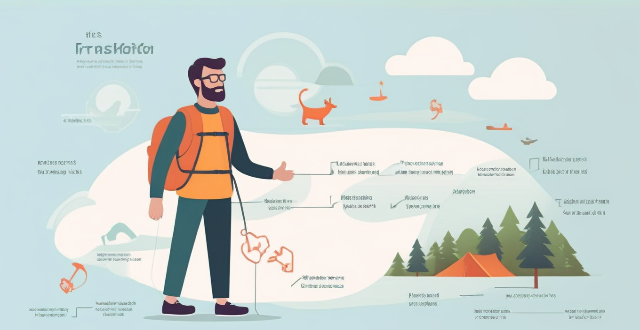Trip Region

How do food festivals impact tourism in a region ?
Food festivals significantly impact tourism in a region, offering economic benefits and promoting cultural exchange. They attract visitors, boost spending, create jobs, and support local businesses. Culinary diversity, community engagement, and media exposure enhance the region's brand image. Sustainability is crucial for supporting local farmers and managing waste. Successful examples include tomato, wine & cheese, and seafood festivals. Food festivals are powerful tools for driving tourism and enriching the travel experience.

How do I plan a backpacking trip on a budget ?
This guide outlines how to plan a budget-friendly backpacking trip by defining a realistic budget, choosing an affordable destination, traveling during off-peak season, opting for budget accommodations, cooking own meals, using public transport, engaging in free activities, packing light, staying connected affordably, and not skimping on trip insurance. It emphasizes the importance of research, flexibility, and openness to new experiences for a memorable adventure without financial strain.

What is the ideal duration for a European backpacking holiday ?
The ideal duration for a European backpacking holiday depends on factors such as budget, travel style, and the number of destinations. A short trip (1-2 weeks) is suitable for those with limited time or a tight budget, focusing on one or two countries or regions. A medium-length trip (3-4 weeks) allows for a more balanced approach, visiting several countries or regions and spending enough time in each location. A long trip (5 weeks or more) is ideal for those with a flexible schedule and budget, providing ample time to explore multiple countries and off-the-beaten-path destinations.

Is it safe to drive at night during a road trip ?
Driving at night during a road trip can be exhilarating but also risky due to reduced visibility and potential for drowsiness. To ensure a safe journey, consider safety precautions such as checking headlights and fog lights, taking breaks every two hours or 100 miles, being extra vigilant in areas with wildlife, maintaining vehicle condition, using technology wisely, being prepared for emergencies, checking weather conditions, obeying legal requirements and regulations, and getting adequate sleep before starting the trip. By following these guidelines, you can help ensure a safer journey under the stars.

What are the best routes for a Canadian road trip ?
Canada is a land of diverse landscapes, from the rugged mountains to the vast coastline. A road trip across this beautiful country can be an unforgettable experience. Here are some of the best routes for a Canadian road trip: - The Trans-Canada Highway (Route 1) - The Cabot Trail, Nova Scotia - Icefields Parkway, Alberta - Dempster Highway, Yukon - Pacific Rim Highway, British Columbia

How long before my trip should I buy travel insurance ?
Travel insurance is a crucial component of any trip, offering coverage for unexpected events such as medical emergencies, trip cancellations, and lost luggage. The best time to buy travel insurance depends on various factors, including the timing of your purchase, trip details, personal situation, and research. Timing matters when buying travel insurance. It's recommended to buy early for peace of mind, better pricing, and more options. However, waiting too long can increase the risk of forgetting, limit options, and create coverage gaps. Trip details such as destination, length of stay, and activities should also be considered. Personal situation factors like health status, financial protection, and travel companions' needs should also influence the timing of your purchase. Practical steps include researching policies, comparing online, reading reviews, consulting a broker, completing an online application, confirming details, and keeping records. Ideally, travel insurance should be purchased at least a few weeks before the trip to ensure adequate coverage and avoid last-minute stressors.

What are the best practices for packing light for a road trip adventure ?
Packing light for a road trip adventure is key to enjoying the journey without being weighed down by excess baggage. Best practices include planning outfits in advance, using packing cubes or compression sacks, rolling clothing instead of folding, sticking to a color scheme, opting for travel-size toiletries, wearing bulkiest items on the plane, and limiting accessories. By following these tips, you can ensure an enjoyable and stress-free road trip adventure.

What are the top road trip destinations in South America ?
South America offers a variety of road trip destinations, including Patagonia with its national parks and glaciers, Ruta 40 in Argentina for diverse landscapes, the Brazilian coastline with its beaches and culture, Carretera Austral in Chile connecting picturesque villages, and the Pan-American Highway stretching from Colombia to Argentina. These routes provide opportunities to explore stunning nature, rich culture, and vibrant cities.

How can I plan a perfect weekend trip to a nearby city ?
How to plan a perfect weekend trip to a nearby city.

How should I prepare my vehicle for a long-distance road trip ?
Preparing Your Vehicle for a Long-Distance Road Trip A long-distance road trip is an exciting adventure, but it's essential to ensure that your vehicle is in top condition before hitting the open road. Here are some steps you can take to prepare your car for the journey ahead: Check the basics such as tires, fluids, lights, and battery. Perform safety checks on brakes, suspension, belts, and hoses. Make sure your entertainment system and charging ports are working correctly. Consider installing seat covers and using organizers or storage solutions to keep items tidy and accessible during the trip. Don't forget to pack an emergency kit with jumper cables, a flashlight, reflective triangles, and a first aid kit just in case you encounter any issues along the way.

Can I extend my travel insurance coverage if I extend my trip ?
Topic: Extending Travel Insurance Coverage Summary: If you extend your trip, you may need to extend your travel insurance coverage. This depends on your policy's terms and the flexibility of your insurer. To extend coverage, contact your provider, provide details about your extended trip, pay an additional premium, and confirm the extension in writing. Consider timing, potential coverage changes, and alternatives if necessary.

Where can I find recommendations for a coastal road trip in California ?
California's coastline is a treasure trove for road trippers, with stunning views and diverse attractions. Starting points like San Francisco or Los Angeles offer unique experiences, from exploring iconic landmarks to enjoying the laid-back beach culture. Key highways such as Highway 1 and the Pacific Coast Highway provide access to picturesque towns and natural wonders. Northern California highlights include Mendocino's Victorian charm, Big Sur's majestic landscapes, and Monterey's marine life. Central California offers Hearst Castle's grandeur and San Luis Obispo's historic missions. Southern California beckons with Santa Barbara's sophistication and Los Angeles' entertainment hub. Along the way, enjoy hiking, whale watching, kayaking, and visiting wineries. Plan your trip considering timing, accommodations, weather, and vehicle readiness for a smooth journey.

What happens if I need to cancel my trip after purchasing travel insurance ?
If you need to cancel your trip after purchasing travel insurance, review your policy for coverage details and time limitations. Contact your insurer to inform them about the cancellation and provide necessary documentation. File a claim by submitting a claim form with supporting documents. Wait for reimbursement, which may vary in processing time and method. Consider rescheduling instead of cancelling if your policy includes trip interruption coverage. Understand that there might be non-refundable expenses even with coverage. Each policy is different, so review your specific policy details and contact your insurer for tailored guidance.

What are the must-have travel packing accessories for a comfortable trip ?
When planning for a trip, packing the right accessories is crucial to ensure comfort and convenience. Essential items include packing cubes, travel pillows, earplugs, portable chargers, water bottles, sunscreen, rain gear, versatile clothing, first aid kits, and compression bags. Each item serves a specific purpose, such as organization, neck support, noise reduction, device charging, hydration, sun protection, rain preparedness, space-saving in luggage, health care, and efficient use of suitcase space. Selecting these accessories based on individual trip needs can greatly enhance the traveling experience.

What kind of clothing should I pack for a trip to Africa ?
When packing for a trip to Africa, it's important to consider the climate and culture of the region you'll be visiting. Here are some essential clothing items to pack: - Lightweight and breathable fabrics such as cotton, linen, and rayon. - Long sleeve shirts and pants to protect your skin from the sun and insects. - A wide-brimmed hat to shade your face and neck. - Comfortable walking shoes or sandals with good support. - A light jacket or sweater for cooler evenings. - Sunglasses and sunscreen with high SPF protection. - Insect repellent to keep mosquitoes and other bugs at bay. It's also important to dress respectfully when traveling in Africa. Many African countries have conservative dress codes, especially in rural areas. Here are some tips to keep in mind: * Avoid wearing revealing or tight-fitting clothing. * Cover your shoulders and knees when visiting religious sites or conservative communities. * Women may want to bring a scarf or pashmina to cover their hair in certain situations. * Avoid wearing excessive amounts of jewelry or expensive accessories, as this can attract unwanted attention. The climate in Africa varies widely depending on the region and season. Here are some general guidelines for different seasons: Dry Season (November to April): * Lightweight clothing made of natural fibers like cotton and linen. * Shorts, skirts, and t-shirts for hot weather. * A light jacket or sweater for cooler evenings. * Sunglasses and sunscreen with high SPF protection. Wet Season (May to October): * Waterproof jacket or raincoat. * Quick-drying clothes that can be easily washed and dried. * Warm layers for cooler temperatures, especially in the evenings. * Insect repellent to keep mosquitoes and other bugs at bay. Year-Round Tips: * Pack clothing in neutral colors that can be mixed and matched easily. * Bring comfortable walking shoes or sandals with good support. * Don't forget a swimsuit if you plan on going to the beach or taking part in water activities. * Pack a small first aid kit with basic supplies like bandages, antiseptic wipes, and pain relievers.

How do I choose the right rental car for a road trip ?
When planning a road trip, selecting the right rental car is crucial for comfort, safety, and enjoyment. Here's how to make the best choice: **Consider Your Travel Needs** - Number of Passengers: Determine how many people will be traveling with you. A compact car might suffice for two adults, but a larger group may require an SUV or minivan. - Luggage Space: Think about the amount of luggage you'll have. If you're packing heavily or bringing bulky items like sports equipment, opt for a car with ample trunk space or a hatchback. **Assess the Terrain** - City Driving: If your trip involves mostly city driving, a smaller, fuel-efficient car will be easier to navigate through traffic and park. - Rural or Mountainous Areas: For winding roads and rough terrain, consider a vehicle with better handling and ground clearance, like an SUV or an all-wheel drive vehicle. **Set Your Budget** - Fuel Economy: Check the fuel efficiency ratings of different cars. A more economical car can save you money on gas during your trip. - Rental Rates: Look at the daily or weekly rates for different types of vehicles. Higher-end models and larger vehicles typically cost more to rent. **Check for Features and Add-ons** - GPS and Navigation: Decide if you need in-car navigation. Some rentals come with built-in systems or you might use your smartphone with a mount. - Entertainment: If you'll have children on board, look for rentals that offer rear-seat entertainment systems to keep them occupied. **Safety First** - Safety Ratings: Research the safety ratings of the rental cars you're considering. Choose vehicles with high safety scores to protect you and your passengers. - Emergency Kit: Ensure the rental includes an emergency kit (e.g., spare tire, jack, jumper cables) in case of unforeseen circumstances. **Read Reviews and Ask Questions** - Customer Experience: Read reviews from previous renters to learn about their experiences with specific car models or rental companies. - Insurance Options: Understand the insurance options provided by the rental company and whether it's worth purchasing additional coverage. **Book Early for Best Deals** - Advance Reservations: The earlier you book, the more likely you are to get the car you want at a better rate. - Comparison Shop: Use comparison websites to find the best deals among various rental companies.

What are the most child-friendly hotels or resorts for a family trip ?
When planning a family trip, it's important to choose accommodations that cater to the needs of both adults and children. Some of the most child-friendly hotels or resorts for a family trip include Club Med Resorts, Disney Resorts, Beaches Resorts, Great Wolf Lodge, Aulani, A Disney Resort & Spa, and Four Seasons Resorts. These properties offer amenities such as kid-friendly pools, water parks, supervised clubs, and cultural experiences. When choosing a hotel or resort for your family trip, consider factors such as location, amenities, activities, and overall atmosphere. Look for properties that offer supervised kids' clubs, family-friendly restaurants, and opportunities for both parents and children to relax and have fun together.

What are some common mistakes to avoid when planning a backpacking trip ?
When planning a backpacking trip, it's important to avoid common mistakes that can compromise safety and enjoyment. These include not researching the trail or destination, overestimating your abilities, bringing inadequate gear, packing too much or too little, ignoring weather forecasts, neglecting food and water preparation, traveling solo without a plan, and ignoring Leave No Trace principles. By avoiding these mistakes, you'll be better prepared for a safe and enjoyable backpacking trip. Remember to always prioritize your safety, respect the environment, and have fun exploring the great outdoors!

Are there any apps that help in planning a road trip route with attractions and food stops ?
When planning a road trip, there are several apps available that can assist in route planning, finding attractions, and discovering food stops and restaurants. Google Maps offers turn-by-turn directions, points of interest, and customization options. Roadtrippers helps plan a comprehensive itinerary, suggests interesting places to visit, and offers themed trips. Sygic Travel provides information on top attractions, offline maps, and route optimization. Waze offers real-time traffic updates, community-driven features, and voice commands for safer driving. For food stops and restaurants, Yelp provides restaurant reviews, filtering options, and user photos. OpenTable allows reservations, dining specials, and cuisine type filtering. Zomato offers menu viewing, user ratings, and food photos. TripAdvisor provides traveler reviews, top restaurant listings, and nearby options. Combination apps like TripIt offer itinerary management, attraction and dining suggestions, and integration with other apps. Maps.me provides offline maps, POI categories, and custom routing. RV Trip Wizard plans RV-friendly routes, includes campground information, and lists attractions and restaurants suitable for RVers. TouristEye accesses pre-made guides, creates custom itineraries, and allows collaborative planning. Overall, these apps make it easier than ever to plan the perfect road trip by combining features such as route planning, finding attractions, and discovering food stops and restaurants into one comprehensive tool.
![Are there any travel warnings or advisories that I should be aware of before planning a trip to [insert destination] ?](/imgs/2f8b31ee-f62a-46e3-8828-37a4af062f9b.png)
Are there any travel warnings or advisories that I should be aware of before planning a trip to [insert destination] ?
Before planning a trip to [insert destination], itBefore planning a trip to [insert destination], it of any travel warnings or it is important to be aware of any travel warnings or advisories that may affect your safety and well-being. Here are some steps you can take to ensure a safe and enjoyable trip: 1. Check the government website of the country you plan to visit for an overview of the current situation and any travel warnings or advisories that have been issued. 2. Research local news sources in the destination country to get a better understanding of the current situation and any potential risks. 3. Contact your embassy or consulate directly if you have any specific concerns about traveling to the destination country. 4. Consider purchasing travel insurance to provide coverage for unexpected events such as medical emergencies, trip cancellations, or lost luggage. By following these steps, you can ensure a safe and enjoyable trip while minimizing any potential risks.

What is the best time of year to visit Africa for an adventure trip ?
The best times to visit Africa for an adventure trip vary by region and activity. East African countries like Kenya, Tanzania, and Uganda are best visited from June to October during the dry season, ideal for safaris and hiking. Southern Africa, including South Africa, Botswana, Zambia, and Zimbabwe, is suitable for visits from May to September, offering great opportunities for safaris and water sports. West Africa, encompassing Ghana, Nigeria, and Senegal, is recommended from November to February for historical tours, cultural experiences, and beach relaxation. Overall, the dry season from May to October is generally considered the best time for outdoor activities across most of Africa.

How do I prepare a travel first aid kit for my next trip ?
When preparing for your next adventure, it's essential to pack a travel first aid kit. This will ensure that you are prepared for any unexpected injuries or illnesses that may occur while away from home. Here are some steps to follow when creating your own travel first aid kit: 1. Choose the right bag or container that is durable, compact, and easy to carry. A waterproof bag with multiple compartments and pockets is ideal as it allows for efficient organization of supplies. 2. Pack essential medical supplies such as bandages, antiseptic wipes, gauze pads, adhesive tape, and scissors. These items are crucial for treating cuts, scrapes, and other minor injuries. Include pain relievers, allergy medication, and motion sickness pills. 3. If taking regular medications, bring enough to last throughout the trip. Over-the-counter drugs like antacids, laxatives, and anti-diarrheal pills should also be packed, along with any prescription medications needed. 4. Depending on the destination and activities planned, specialized items may be necessary. For example, insect repellent, sunscreen, and blister kits are useful for hiking or camping trips. Anti-malarial medication and water purification tablets are important for tropical climates. 5. Customize the travel first aid kit based on individual needs. If allergies or chronic conditions exist, include appropriate medications and supplies. Don't forget to pack a small first aid manual or guidebook for reference in case of an emergency.

What should I do to ensure my personal safety during a backpacking trip ?
Backpacking trips can be an exhilarating adventure, but it's crucial to prioritize personal safety. Here are some essential tips to help you stay safe while enjoying the great outdoors: ## Research and Plan Ahead - **Research the area**: Familiarize yourself with the terrain, weather patterns, and potential hazards of your destination. - **Plan your route**: Create a detailed itinerary and share it with someone who is not accompanying you on the trip. - **Check the forecast**: Keep an eye on the weather and be prepared to adjust your plans accordingly. ## Essential Gear and Equipment - **Pack appropriate gear**: Ensure you have all the necessary equipment, including a tent, sleeping bag, cooking supplies, and navigation tools. - **Wear proper clothing**: Dress in layers and choose fabrics that can handle various weather conditions. - **Carry a first aid kit**: Include items such as bandages, antiseptic wipes, and any prescription medications you might need. ## Stay Informed and Connected - **Bring a map and compass**: Even if you have a GPS device or smartphone, traditional navigation tools can be lifesavers. - **Have a reliable means of communication**: Carry a charged cell phone and consider bringing a satellite phone or emergency beacon for remote areas. - **Know where to find help**: Locate the nearest ranger station, medical facility, or other sources of assistance before you set out. ## Practice Good Trail Etiquette - **Stick to established trails**: Avoid veering off the path to minimize your impact on the environment and reduce the risk of getting lost. - **Respect wildlife**: Maintain a safe distance from animals and never approach them. - **Be aware of other hikers**: Yield appropriately and communicate clearly when passing others on the trail. ## Follow Basic Safety Guidelines - **Hike with a partner**: Having someone with you can significantly increase your safety. - **Avoid hiking at night**: Visibility is limited, and nocturnal creatures are more active after dark. - **Stay hydrated and nourished**: Drink plenty of water and eat regular meals to maintain your energy levels. By following these guidelines, you can enjoy a safe and enjoyable backpacking trip while minimizing risks and being prepared for any situation that may arise. Remember, safety should always be your top priority when venturing into the wilderness.

What are the top luxury island experiences for a honeymoon or anniversary trip ?
Top Luxury Island Experiences for a Honeymoon or Anniversary Trip include Bora Bora in French Polynesia, Santorini in Greece, the Maldives, Mauritius, and Necker Island in the British Virgin Islands. Each destination offers unique experiences such as crystal clear waters, luxury overwater bungalows, sunset cruises, iconic caldera views, private catamaran excursions, indulgent spa treatments, secluded beaches, underwater dining, world-class diving, tropical forests and waterfalls, sailing and watersports, cultural exploration, exclusive private island experiences, world-class facilities, and personalized service. These islands provide the perfect setting for a romantic and adventurous honeymoon or anniversary trip filled with relaxation and unforgettable memories.

What are the most scenic routes for a road trip in the US ?
The United States is home to some of the most breathtaking landscapes in the world, making it an ideal destination for a road trip. Here are some of the most scenic routes you can take: 1. Pacific Coast Highway (California) - This iconic drive takes you along the coastline of California, offering stunning views of the ocean and rugged cliffs. Highlights include Big Sur, San Francisco, and Los Angeles. 2. Blue Ridge Parkway (Virginia/North Carolina) - A 469-mile scenic drive that winds through the Appalachian Mountains, taking you through lush forests, rolling hills, and charming small towns. Highlights include Shenandoah National Park, Asheville, and Great Smoky Mountains National Park. 3. Going-to-the-Sun Road (Montana) - A 52-mile scenic drive through Glacier National Park in Montana, taking you through snow-capped mountains, alpine meadows, and crystal-clear lakes. Highlights include Lake McDonald, Logan Pass, and St. Mary Lake. 4. Hana Highway (Hawaii) - A 52-mile winding road that runs along the coastline of Maui in Hawaii, taking you through tropical rainforests, cascading waterfalls, and black sand beaches. Highlights include Wailuku Falls, Hana Town, and Waianapanapa State Park.
![What are the best cycling routes in [city/region] ?](/imgs/2f8b31ee-f62a-46e3-8828-37a4af062f9b.png)
What are the best cycling routes in [city/region] ?
Cycling is a great way to explore the beautiful landscapes and attractions of [city/region]. Here are some of the best cycling routes that you can take: 1. Coastal Route: Start at [location] and end at [location]. Distance: [distance]. Difficulty level: [level]. Scenic spots: [spots]. 2. Countryside Route: Start at [location] and end at [location]. Distance: [distance]. Difficulty level: [level]. Scenic spots: [spots]. 3. Mountainous Route: Start at [location] and end at [location]. Distance: [distance]. Difficulty level: [level]. Scenic spots: [spots]. 4. Urban Route: Start at [location] and end at [location]. Distance: [distance]. Difficulty level: [level]. Scenic spots: [spots]. Remember to bring essential items such as water, snacks, a map, and a first aid kit. Wear appropriate clothing and gear, and always follow traffic rules and regulations.

What is the potential for wind energy in my region ?
The potential for wind energy in a region depends on geographical features, wind speed and consistency, governmental policies, environmental and social considerations, and infrastructure accessibility. Coastal areas, plateaus, mountain passes, and open plains typically have better wind energy potential due to consistent wind patterns and less obstruction. High average wind speeds and consistency are crucial for effective power generation. Governmental policies such as Renewable Portfolio Standards, feed-in tariffs, and tax credits can encourage wind energy development. Environmental and social considerations include wildlife impact, visual and noise pollution, and local economy effects. Infrastructure and accessibility to power grids and transportation networks are also important factors.

What are the most popular local snacks in your region ?
The text introduces the popular local snacks in my region, including **Samosas**, **Chaat**, **Vada Pav**, etc. Samosas are crispy pastries filled with spiced potatoes and peas; Chaat is a street food dish made with fried dough balls and spicy fillings; Vada Pav is a sandwich with deep-fried potato patties and spicy chutneys; Jhal Muri is a spicy snack mix of puffed rice, sev, peanuts, spices, and herbs; Lassi is a refreshing yogurt-based drink in various flavors. These snacks are not only delicious but also reflect the cultural heritage and culinary traditions of the area.
![What are the best photography locations in [insert country/region] ?](/imgs/2f8b31ee-f62a-46e3-8828-37a4af062f9b.png)
What are the best photography locations in [insert country/region] ?
The text provides a comprehensive guide to the best photography locations in a specified country or region. It is divided into three main categories: Natural Wonders, Cultural Landmarks, and Scenic Viewpoints. Within each category, specific locations are suggested based on their unique features and photographic potential. Under Natural Wonders, Mountain Ranges, Waterfalls, and Coastal Landscapes are discussed with specific examples given for each type of landscape. Cultural Landmarks include Historic Buildings and Museums and Art Galleries, highlighting architectural beauty and artistic expression respectively. Lastly, Scenic Viewpoints cover Lookout Points and Parks and Gardens, showcasing panoramic views and natural beauty. The guide emphasizes the variety of photographic opportunities available in the specified location, encouraging photographers of all styles and preferences to explore and capture the essence of the place through their lenses.

What does a typical travel insurance cover ?
Travel insurance typically covers medical expenses, trip cancellation and interruption, baggage loss and delay, accidental death and dismemberment, and emergency assistance services. Optional extras may include coverage for sports and adventure activities, rental car damage, and travel delay. It's important to consider the specific needs of your trip when selecting a policy and to carefully read the details to understand coverage limits and exclusions.